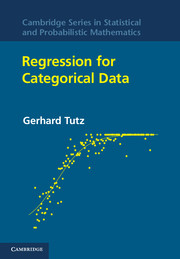Book contents
- Frontmatter
- Contents
- Preface
- 1 Introduction
- 2 Binary Regression: The Logit Model
- 3 Generalized Linear Models
- 4 Modeling of Binary Data
- 5 Alternative Binary Regression Models
- 6 Regularization and Variable Selection for Parametric Models
- 7 Regression Analysis of Count Data
- 8 Multinomial Response Models
- 9 Ordinal Response Models
- 10 Semi- and Non-Parametric Generalized Regression
- 11 Tree-Based Methods
- 12 The Analysis of Contingency Tables: Log-Linear and Graphical Models
- 13 Multivariate Response Models
- 14 Random Effects Models and Finite Mixtures
- 15 Prediction and Classification
- A Distributions
- B Some Basic Tools
- C Constrained Estimation
- D Kullback-Leibler Distance and Information-Based Criteria of Model Fit
- E Numerical Integration and Tools for Random Effects Modeling
- List of Examples
- Bibliography
- Author Index
- Subject Index
14 - Random Effects Models and Finite Mixtures
Published online by Cambridge University Press: 05 June 2012
- Frontmatter
- Contents
- Preface
- 1 Introduction
- 2 Binary Regression: The Logit Model
- 3 Generalized Linear Models
- 4 Modeling of Binary Data
- 5 Alternative Binary Regression Models
- 6 Regularization and Variable Selection for Parametric Models
- 7 Regression Analysis of Count Data
- 8 Multinomial Response Models
- 9 Ordinal Response Models
- 10 Semi- and Non-Parametric Generalized Regression
- 11 Tree-Based Methods
- 12 The Analysis of Contingency Tables: Log-Linear and Graphical Models
- 13 Multivariate Response Models
- 14 Random Effects Models and Finite Mixtures
- 15 Prediction and Classification
- A Distributions
- B Some Basic Tools
- C Constrained Estimation
- D Kullback-Leibler Distance and Information-Based Criteria of Model Fit
- E Numerical Integration and Tools for Random Effects Modeling
- List of Examples
- Bibliography
- Author Index
- Subject Index
Summary
In Chapter 13 the marginal modeling approach has been used to model observations that occur in clusters. An alternative approach to dealing with repeated measurements is by modeling explicitly the heterogeneity of the clustered responses. By postulating the existence of unobserved latent variables, the so-called random effects, which are shared by the measurement within a cluster, one introduces correlation between the measurements within clusters.
The introduction of cluster-specific parameters has consequences on the interpretation of parameters. Responses are modeled given covariates and cluster-specific terms. Therefore, interpretation is subject-specific, in contrast to marginal models, which have population-averaged interpretations. For illustration let us consider Example 13.4, where a binary response indicating pain depending on treatment and other covariates is measured repeatedly. When each individual has its own parameter, which represents the individual's sensitivity to pain, modeling of the response given the covariates and the individual level means that effects are measured on the individual level. For non-linear models, which are the standard in categorical regressions, the effect strength will differ from the effect strength found in marginal modeling without subject-specific parameters. The difference will be discussed in more detail in Section 14.2.1 for the simple case of binary response models with random intercepts.
Explicit modeling of heterogeneity by random effects is typically found in repeated measurements, as in the pain study. In the following we give two more examples.
Example 14.1: AIDS Study
The data were collected within the Multicenter AIDS Cohort Study (MACS), which has followed nearly 5000 gay or bisexual men from Baltimore, Pittsburgh, Chicago, and Los Angeles since 1984 (see Kaslow et al., 1987; Zeger and Diggle, 1994).
Information
- Type
- Chapter
- Information
- Regression for Categorical Data , pp. 395 - 428Publisher: Cambridge University PressPrint publication year: 2011
